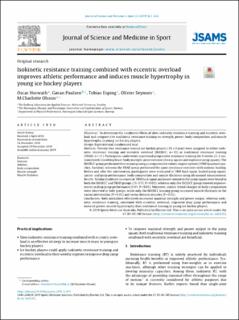| dc.contributor.author | Horwath, Oscar | |
| dc.contributor.author | Paulsen, Gøran | |
| dc.contributor.author | Esping, Tobias | |
| dc.contributor.author | Seynnes, Olivier R. | |
| dc.contributor.author | Olsson, Monica Charlotte | |
| dc.date.accessioned | 2020-03-10T10:18:18Z | |
| dc.date.available | 2020-03-10T10:18:18Z | |
| dc.date.created | 2019-05-03T11:12:33Z | |
| dc.date.issued | 2019 | |
| dc.identifier.citation | Journal of Science and Medicine in Sport. 2019, 22(7), 821-826. | en_US |
| dc.identifier.issn | 1440-2440 | |
| dc.identifier.uri | https://hdl.handle.net/11250/2646163 | |
| dc.description | This is an open access article under the CC BY-NC-ND license (http://creativecommons.org/licenses/by-nc-nd/4.0/). | en_US |
| dc.description.abstract | Objectives: To determine the combined effects of slow isokinetic resistance training and eccentric overload and compare it to traditional resistance training on strength, power, body composition and muscle hypertrophy in young ice hockey players.
Design: Experimental, randomized trial.
Methods: Twenty-two resistance-trained ice hockey players (18 ± 1 year) were assigned to either isokinetic resistance training and eccentric overload (ISO/ECC; n = 11) or traditional resistance training (TRAD; n = 11). Participants underwent supervised progressive resistance training for 8 weeks (2–3 sessions/week)involving lower body multiple-joint exercises (heavy squats and explosive jump squats). The ISO/ECC group performed their training using a computerized robotic engine system (1080 Quantum synchro, Sweden), whereas the TRAD group performed the same resistance exercises with isotonic loading. Before and after the intervention, participants were evaluated in 1RM back squat, loaded jump squats, sprint- and jump performance, body composition and muscle thickness using ultrasound measurement.
Results: Similar moderate increases in 1RM back squat and power outputin the jump squats were found in both the ISO/ECC and TRAD groups (11–17%, P < 0.01), whereas only the ISO/ECC group showed improvements in drop jump performance (9.8%, P = 0.01). Moreover, similar trivial changes in body composition were observed in both groups, while only the ISO/ECC training group increased muscle thickness in the vastus intermedius (P = 0.01) and rectus femoris muscles (P = 0.03).
Conclusions: Both modalities effectively increased maximal strength and power output, whereas isokinetic resistance training, combined with eccentric overload, improved drop jump performance and induced greater muscle hypertrophy than traditional training in young ice hockey players. | en_US |
| dc.language.iso | eng | en_US |
| dc.subject | exercise | en_US |
| dc.subject | athletes | en_US |
| dc.subject | body composition | en_US |
| dc.subject | muscle strength | en_US |
| dc.subject | muscle thickness | en_US |
| dc.title | Isokinetic resistance training combined with eccentric overload improves athletic performance and induces muscle hypertrophy in young ice hockey players | en_US |
| dc.type | Peer reviewed | en_US |
| dc.type | Journal article | en_US |
| dc.description.version | publishedVersion | en_US |
| dc.rights.holder | © 2019 Sports Medicine Australia | en_US |
| dc.source.pagenumber | 821-826 | en_US |
| dc.source.volume | 22 | en_US |
| dc.source.journal | Journal of Science and Medicine in Sport | en_US |
| dc.source.issue | 7 | en_US |
| dc.identifier.doi | 10.1016/j.jsams.2018.12.017 | |
| dc.identifier.cristin | 1695377 | |
| dc.description.localcode | Seksjon for fysisk prestasjonsevne / Department of Physical Performance | en_US |
| cristin.unitcode | 150,31,0,0 | |
| cristin.unitname | Seksjon for fysisk prestasjonsevne | |
| cristin.ispublished | true | |
| cristin.fulltext | original | |
| cristin.qualitycode | 1 | |
